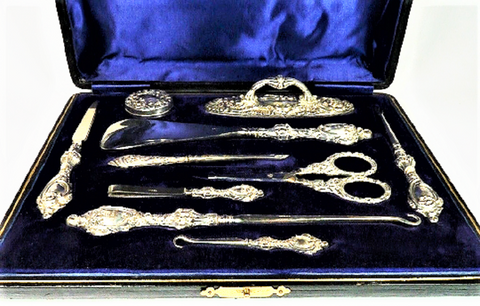#Silversmith #William #Devenport #Son #History
.
The origins of the esteemed maker known as William Devenport began in early Victorian England in 1837. The firm was founded by Joseph Whitton after whom it was named. When William Devenport became a partner it was styled as Whitton & Devenport. Later on this jewellery concern was known as William Devenport and when his son joined the firm, William restyled the business name to William Devenport & Son.
The maker became particularly well known for their fitted dressing sets which were encased in smart leather clad cases. Each item was placed in a tight fitting custom made recess which would prevent the items from moving once the lid was closed. The silk lining of the lids was often padded with lambs wool to offer protection to the contents of the cases. Ladies and gentlemen’s grooming sets were an ideal way to transport what was needed on the dressing tables of the well groomed who wished to travel.
There were a variety of different types of transport for well heeled Edwardians. Although many vehicles were horse-drawn, the towns and cities were served by train, tram and bus networks. Some families owned motor cars.
As you can see from the set below, the contents of a lady’s dressing table could safely be transported to her holiday destination or when visiting the homes of friends & relatives.
The custom made recesses were usually clad with velvet.
Some items have much deeper dimensions. For example the powder / cream container and nail buffer which are shown are the top. The deepest recesses made for the buffer and powder tin are lined with royal blue silk because they extend right down to the wood at the bottom of the case. Whereas the other items rest on velvet clad wooden recesses on a board mounted inside the case.
EDWARDIAN DRESSING SET
In this era the clasps were usually quite ornate. This case has only one. Often cases of this size would have two elegant gilded brass clasps.
This superb set was crafted by William Devenport. Each handle is hallmarked silver and as you would expect the shafts are made from high quality steel, which is traditionally the material used in these pieces for its great strength.
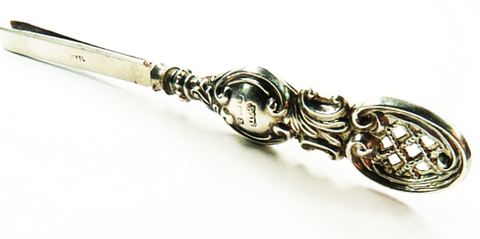
OPENWORK TWEEZERS WITH STEEL SHAFT
The tweezers shown above were also crafted by this maker.
On the shaft it is quite easy to see the word STEEL.
This impressive set comprises a powder / cream container, nail buffer, a nail file, two cuticle pushers, nail scissors, tweezers, a shoe horn & two different sizes of button hooks. All the items are embellished with repoussé work.
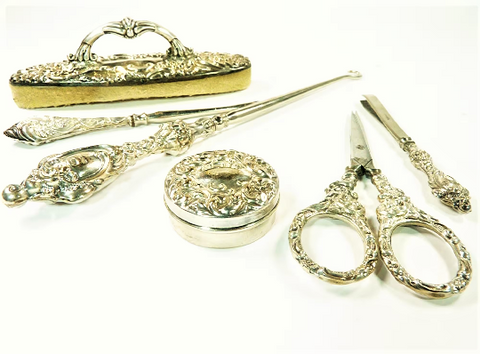
The nail buffer is fitted with chamois to the underside. In the Edwardian era the wearing of makeup was not socially accepted in many stratas of society and so ladies used other ways to enhance their natural beauty. Instead of wearing nail polish nail buffers were used to give a healthy-looking shine. Often chamois buffers were used with a buffing cream that contained fine grit. A small amount of buffing cream was applied to the nail which was then buffed using a criss cross action. When the buffing was finished the nails would be cleaned with water and dried.
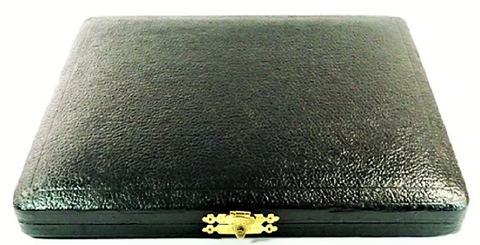
WILLIAM DEVENPORT LEATHER CASE
This elaborately wrought set is presented in the original superb leather clad case with hand tooled borders which have elegant floral motifs on each corner. The leather absolutely gleams as does the ornate gilt clasp.
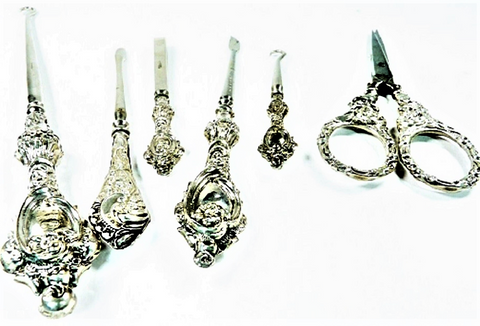
ORNATE REPOUSSAGE HANDLES
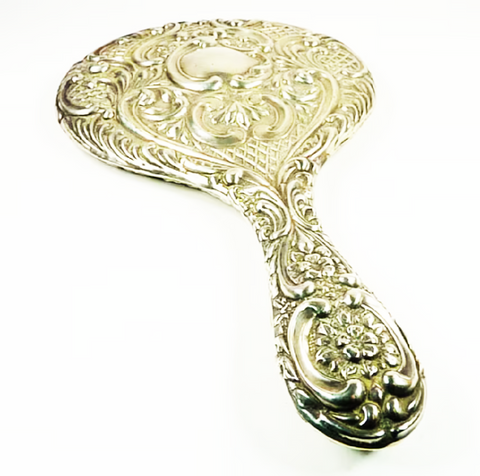
VIEW THIS ORNATE DEVENPORT HAND MIRROR
This magnificent sterling silver Art Nouveau William Devenport hand mirror is adorned with floral chasing, scroll work & the original bevelled mirror.

THE MARK OF WILLIAM DEVENPORT
The mirror is stamped with the maker’s mark (W.D), the place of assay, Brimingham (anchor), the silver purity (lion passant) and the date letter (d) 1903.
Although these hallmarks are easy to read and unworn, this maker would often stamp the marks in areas which were elaborately worked and so they can be very hard to find on such a richly ornamented piece.
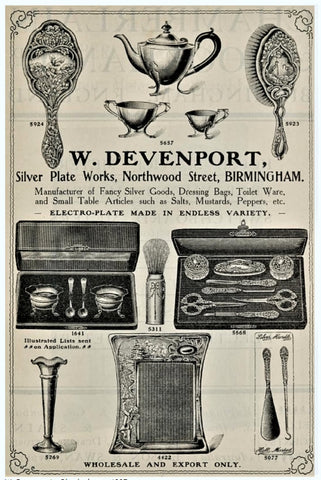
1907 TRADE ADVERTISEMENT
This trade advertisement shows a small selection of the goods made for wholesale or export. Fancy silver goods such as hand mirrors, tea sets, salts, shaving brushes, manicure sets, vases, picture frames, shoe horns and button hooks were fashioned from sterling silver and also electro-plate.
The items featured on this trade advertisement are all embellished with electro-plated silver. These products were much more affordable than similar wares made exclusively from sterling silver.
So far we have only found one patent registered to this maker.
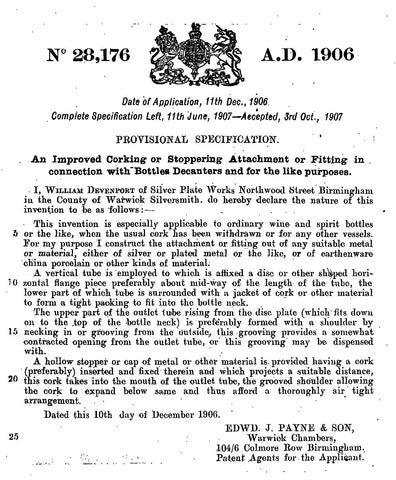
PATENT NO. 190628176
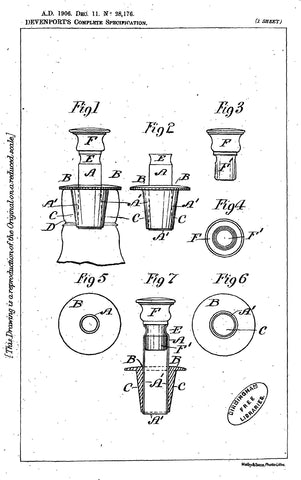
PATENT NO.190628176
PROVISIONAL SPECIFICATION.
An Improved Corking or Stoppering Attachment or Fitting in connection with-Bottles Decanters and for the like purposes.
I, WILLIAM DEVENPORT of Silver Plate Works Northwood Street Birmingham in the County of Warwick Silversmith, do hereby declare the nature of this invention to be as follows: –
This invention is especially applicable to ordinary wine and spirit bottles or the like, when the usual cork has been withdrawn or form-any other vessels.
For my purpose I construct the attachment or fitting out of any suitable metal or material, either of silver or plated metal or the like, or of earthenware china porcelain or other kinds of material.
A vertical tube is employed to which is affixed a disc or other shaped horizontal flange piece preferably about mid-way. of the length of the tube, the lower part of which tube is surrounded with a jacket of cork or other material to form a tight packing to fit into the bottle neck.
The upper part of the outlet tube rising from the disc plate (which fits down on to the top of the bottle neck) is preferably formed with a shoulder by necking in or grooving from the outsider this grooving provides a somewhat contracted opening from the outlet tube, or this grooving may be dispensed with.
A hollow stopper or cap of metal or other material is provided having a cork (preferably) inserted and fixed therein and which projects a suitable distance, this cork takes into the mouth of the outlet tube, the grooved shoulder allowing the cork to expand below same and thus afford a thoroughly air tight arrangement.
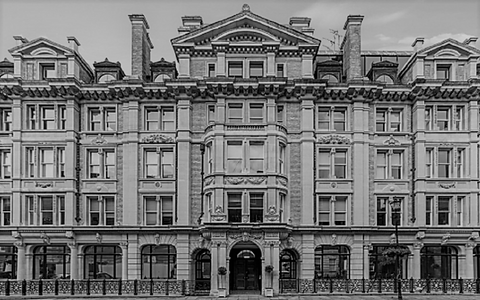
AUDREY HOUSE LONDON EC
As well as supplying the wholesale trade this company presented their silverware at elegant showrooms located at Audrey House, Ely Place, Holborn Place, London EC. They were known to have showrooms at this location between 1912-1913.
Marks for the firm were entered with the London and Birmingham assay offices.
The company helped with the war effort during World War I.

DIRECTORY OF MANUFACTURERS IN ENGINEERING & ALLIED TRADES
1918
The directory listing shown above gives details of this firm’s work during World War I. The company made decorative badges for military uniforms, Royal arms buttons for the armed services. Parts for armaments were also manufactured. They are listed as weights for fuzes, gauges, brass tapes and hot stampings.
Silverware and all manner of electro-plated goods continued to be made by the company during World War I.
The premises listed in this directory, 121 Northwood Street Birmingham was also known as the Silver Plate Works. The company is also listed as gold and silversmiths from this location.
The middle section lists the war work and the section on the right lists the company’s usual work in peacetime as a manufacturing jewellery concern which was noted for its silverware and electro-plated goods.
In 1918 the employees located at the Silver Plate Works numbered 29 men and 39 women.
You can see from the next image the huge difference in style from the sinuous lines of the Art Nouveau era and the Art Deco era.
This sleek sterling silver case is ornamented with an engine turned hexagonal design.
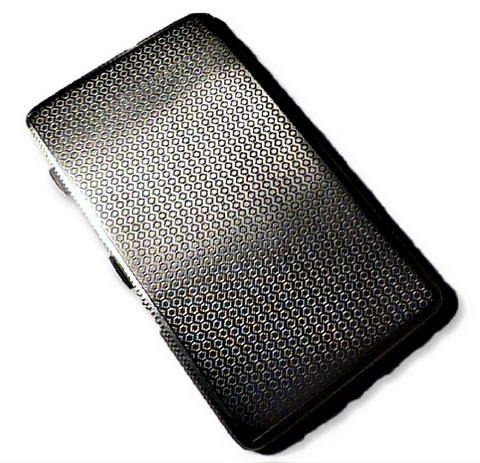
ART DECO WILLIAM DEVENPORT CASE
This Art Deco case is such an elegant piece that it is ideal for either ladies or gentlemen. The lid, base and all sides are decorated with an engine turned design we have not seen before. This piece was assayed at Birmingham in 1930.
Chronology:
Joseph Whitton 1837
Whitton & Devenport
William Devenport
William Devenport & Son
William Deveonport & Co.
Sources:
Patent Office.
Grace’s Guide.
Silvercollection.it

